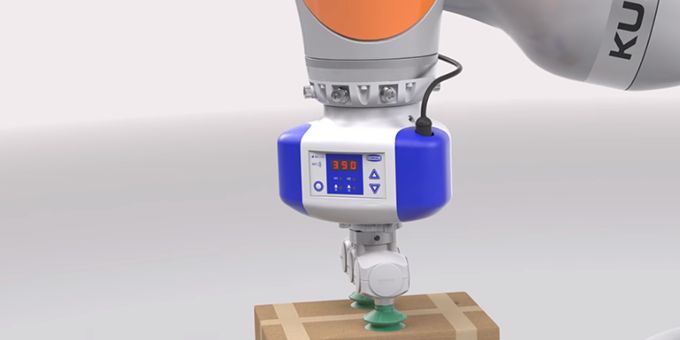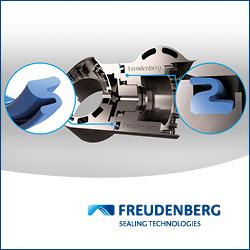In order for electrical vacuum generators, grippers and compact ejectors to be visible to the smart factory, they must provide digital energy and process data in real time.
 Vacuum Technology for the Digital Factory
Vacuum Technology for the Digital Factory

Contributed by | Schmalz
In order for electrical vacuum generators, grippers and compact ejectors to be visible to the smart factory, they must provide digital energy and process data in real time. Schmalz integrates interfaces such as Ethernet IP, IO-Link and NFC in its vacuum components, creating the intelligent foundation needed for networked manufacturing.
Cyber-physical systems are the protagonists of the fourth industrial revolution. They link real objects with virtual objects, i.e. machines with information processing systems. In comparison to the automation wave via electronics and IT that started in the 1970s, the new level of innovation is based on cross-system communication. It enables energy and process control as well as predictive maintenance to be realized as long as the devices contain the corresponding interfaces.
Schmalz specially develops vacuum components for networking in vacuum automation that not only capture energy and performance-related data and deliver it in the cloud, but that monitor and analyze as well. Thanks to IO-Link and Industrial Ethernet interfaces, Smart Field Devices can communicate continuously from the sensor and actuator level to the higher-level controller (PLC) and all the way to the control level. Communication occurs in both directions: In addition to transferring data about condition or energy consumption, the controller can also be used to change parameters and transfer them to the intelligent field device.
.jpg)
Compact terminal SCPSi: Thanks to its modular design, up to 16 individual ejectors can be controlled and configured. Parameterization is performed via app.
In addition to an IO-Link and Industrial Ethernet interface, Schmalz’s intelligent vacuum components also contain an NFC interface (Near Field Communication). In order to exchange information wirelessly over short distances, the Smart Field Device and the user’s NFC-enabled mobile end device are coupled via point-to-point coupling. The component does not require a separate energy source for transmission. Instead, there is a built-in coil that is activated via smartphone. The coil induces a voltage in a processor, which then transmits its information via an antenna. This allows the user to retrieve process data as well as maintenance and service information directly via smartphone.
.jpg)
The electronic vacuum generator ECBPi with IO-Link and NFC was developed for mobile robotics and stationary handling tasks using collaborative robots (cobots).
The device informs the user in a straightforward manner: If there is a standstill, it provides the user with clear information about the source of the problem instead of cryptic error codes. The smartphone can be used to parameterize the component as well. Schmalz programmed the ControlRoom app for this purpose. Parameter changes that were performed via NFC can be transferred directly to the device or copied from one device to another.
An additional benefit of NFC is the ability to directly assign the product to the smartphone. Two devices are connected over a very short distance at a max. of two centimeters. This way, the user can rest assured that no neighboring devices are inadvertently parameterized.
From air flow to data flow
A glance inside the compact terminal SCPSi demonstrates the benefits of digitization on the component level for vacuum applications. It consolidates up to 16 separate vacuum generators into a single compact unit that has just one electrical connection and one compressed air connection. Schmalz makes simultaneous and individual handling of different parts using only one system possible. The vacuum is generated with a venturi nozzle and recorded by a sensor. The user can read out the precise vacuum value via the IO-Link process data or via the generator display.
The cyclical process data is also used to control the ejectors and receive current information reported from the SCPSi. The IO-Link connection settings and parameters as well as measurement and analysis data are likewise available to the user. Furthermore, the vacuum components’ diagnostic and prognosis functions gather information about the condition of the system and identify trends in quality and performance. After transferring the data to an external cloud, it is processed and analyzed, which generates real added value: If the system identifies values that diverge from the tolerance or subtle changes, it quickly and clearly reports them to the user. For example, the system checks leakage and dynamic pressure for predictive maintenance assessments.
Furthermore, condition monitoring events are triggered if dynamic pressure values deviate, the evacuation times for ejectors exceed their limit values or sensor voltage is outside of the work area. The energy monitoring function oversees energy consumption of the connected vacuum systems. Monitoring is based on the measured air consumption, which includes measurements of system pressure and nozzle size. Users can specify an externally recorded pressure value using the IO-Link process data. Using this value, the ejector can measure the absolute air consumption in addition to the air consumption as a percentage.
Quick integration
This range of functions allows the user to maintain an efficient system, avoid machine standstills and increase system availability. IO-Link provides the user with benefits during integration of the compact terminal in the system environment: Schmalz provides an IODD (IO Device Description) file to the user, which is a comprehensive, IO-Link configuration file that contains information about identification, device parameters, process and diagnostic data as well as communication properties. Exchanging devices is also simplified since the IO-Link log provides an automated process for data transfer. When a device is swapped for a new one of the same type, the setting parameters for the old device are automatically saved in the new device by the master.
The compact terminal SCPSi is part of a continuously growing range of intelligent field devices. Their process and condition data make Industry 4.0 concepts possible. Users benefit from rapid commissioning, reliable operation and minimized risk of downtime. In addition to compact ejectors, Schmalz has also equipped the electronic vacuum pressure switch VSi, which measures and monitors underpressure and overpressure in automation and handling systems, as well as the special gripper SNGi-AE and electronic vacuum generator ECBPi with IO-Link and NFC for the digital factory.
The content & opinions in this article are the author’s and do not necessarily represent the views of RoboticsTomorrow
Featured Product

